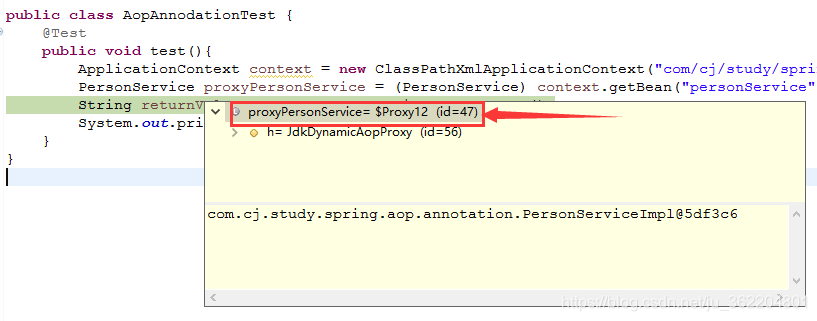上一篇讲了配置文件形式的SpringAOP:Spring中的AOP以及切入点表达式和各种通知
本篇继续看一下注解形式怎么去理解和应用AOP
前几篇已经讲了不少AOP相关的知识,本篇不再赘述,直接用代码写一下注解形式的AOP
举的例子还是前几篇的例子,只不过是用注解的形式去用一下AOP
package com.cj.study.spring.aop.annotation;
public interface PersonService {
public String savePerson();
public void updatePerson();
public void deletePerson();
}
package com.cj.study.spring.aop.annotation;
import org.springframework.stereotype.Repository;
//目标类
@Repository("personService")
public class PersonServiceImpl implements PersonService{
//目标方法
public String savePerson() {
System.out.println("添加");
return "保存成功!";
}
//目标方法
public void updatePerson() {
System.out.println("修改");
}
//目标方法
public void deletePerson() {
System.out.println("删除");
}
}
package com.cj.study.spring.aop.annotation;
import org.aspectj.lang.annotation.After;
import org.aspectj.lang.annotation.Aspect;
import org.aspectj.lang.annotation.Before;
import org.aspectj.lang.annotation.Pointcut;
import org.springframework.stereotype.Component;
/**
*
* @Aspect + @Pointcut()这两个注解就相当于之前配置文件里下边的内容
* <aop:config>
* <aop:pointcut expression="execution(* com.cj.study.spring.aop.*.*(..))" id="perform"/>
* </aop:config>
*
* @Before()这个注解就相当于之前配置文件里
* <aop:aspect ref="myTransaction">
* <aop:before method="beginTransaction" pointcut-ref="perform"/>
* </aop:aspect>
*
* @author caoju
*
*/
//切面类
@Component("myTransaction")
@Aspect
public class MyTransaction {
//这个 aaa() 方法没有其他作用,仅仅是用它来标明一下切入点表达式
@Pointcut("execution(* com.cj.study.spring.aop..*.*(..))")
public void aaa(){
}
//切面里的通知方法
@Before("aaa()")
public void beginTransaction(){
System.out.println("开启事务 ");
}
//切面里的通知方法
@After("aaa()")
public void commit(){
System.out.println("提交事务");
}
}
<?xml version="1.0" encoding="UTF-8"?>
<beans xmlns="http://www.springframework.org/schema/beans"
xmlns:context="http://www.springframework.org/schema/context"
xmlns:aop="http://www.springframework.org/schema/aop"
xmlns:xsi="http://www.w3.org/2001/XMLSchema-instance"
xsi:schemaLocation="http://www.springframework.org/schema/beans
http://www.springframework.org/schema/beans/spring-beans-4.2.xsd
http://www.springframework.org/schema/aop
http://www.springframework.org/schema/aop/spring-aop-2.5.xsd
http://www.springframework.org/schema/context
http://www.springframework.org/schema/context/spring-context-2.5.xsd">
<!-- 配置包扫描器,把目标类和切面类纳入到spring容器中管理 -->
<context:component-scan base-package="com.cj.study.spring.aop.annotation" />
<!-- 启动aop的注解解析器 -->
<aop:aspectj-autoproxy></aop:aspectj-autoproxy>
</beans>
package com.cj.study.spring.aop.annotation;
import org.junit.Test;
import org.springframework.context.ApplicationContext;
import org.springframework.context.support.ClassPathXmlApplicationContext;
public class AopAnnodationTest {
@Test
public void test(){
ApplicationContext context = new ClassPathXmlApplicationContext("com/cj/study/spring/aop/annotation/applicationContext.xml");
PersonService proxyPersonService = (PersonService) context.getBean("personService");
String returnValue = proxyPersonService.savePerson();
System.out.println(returnValue);
}
}
打断点看下返回的是否是代理类

可以看到返回的是$Proxy,说明返回的是代理对象
看下最后的结果

以上就是以注解的形式用了一下AOP
需要知道的是:不管是配置文件的形式还是注解的形式,他们两种实现的功能是一样的
注解形式的可能比配置文件更抽象一点,但是你要清楚它做的事情和配置文件做的是一样的,只是形式上有差别。注解可以对比着配置文件去理解,我已经在代码里进行了注释
不管是配置文件还是注解,最终都要用反射来实现,关于反射和注解,我之前的文章也写过
感兴趣的小可爱,可以自行参考
